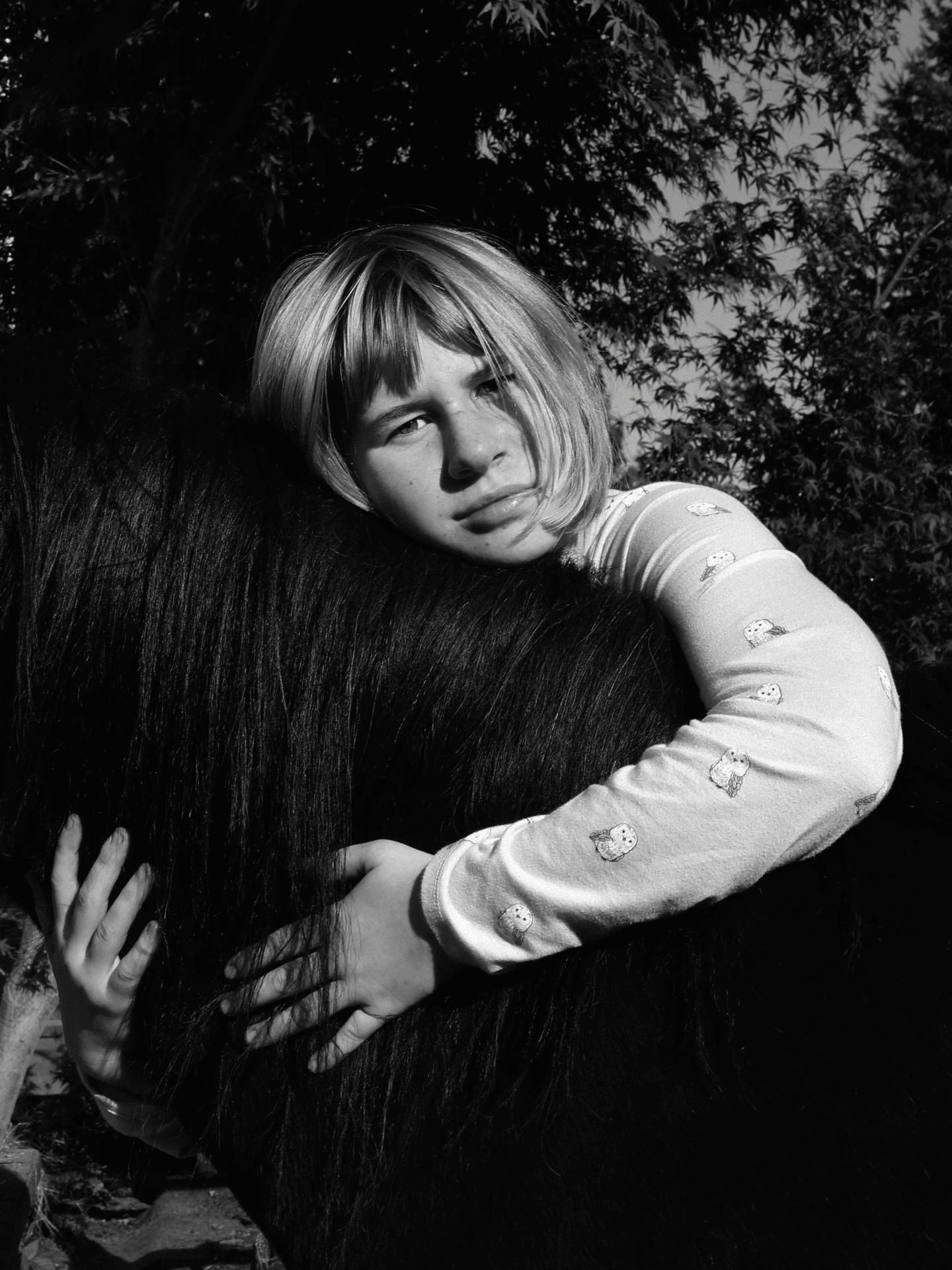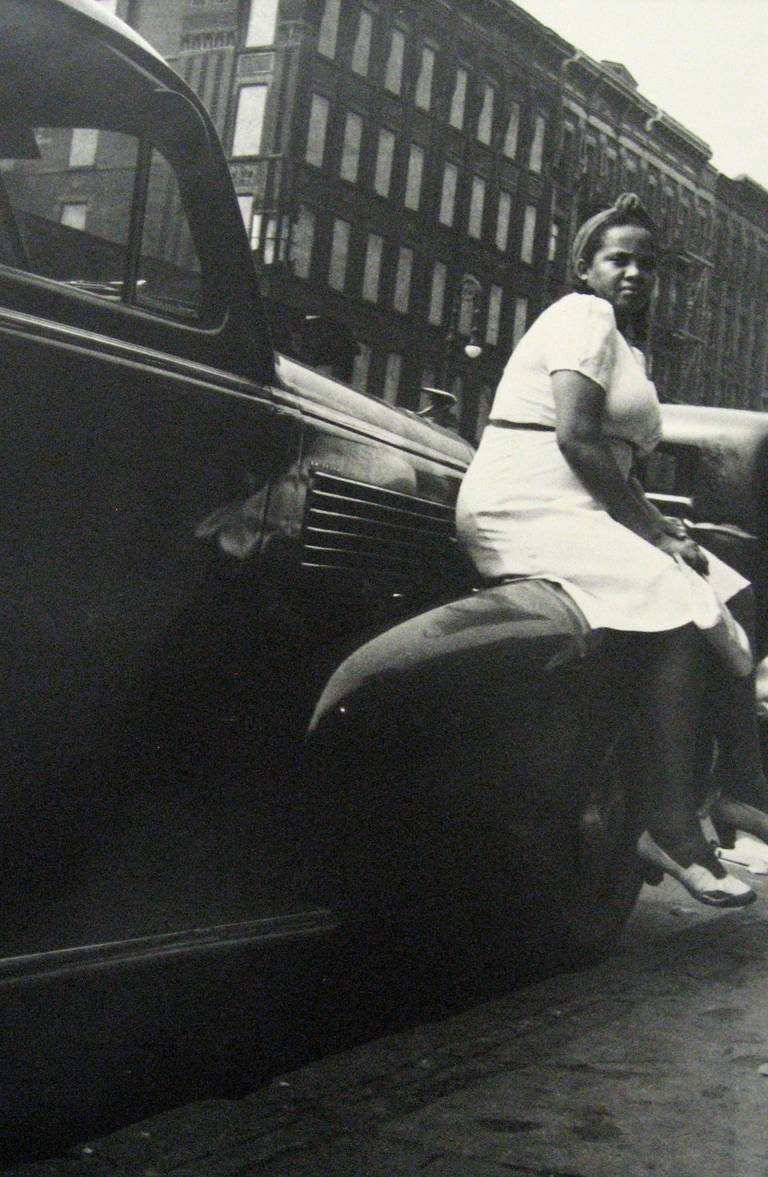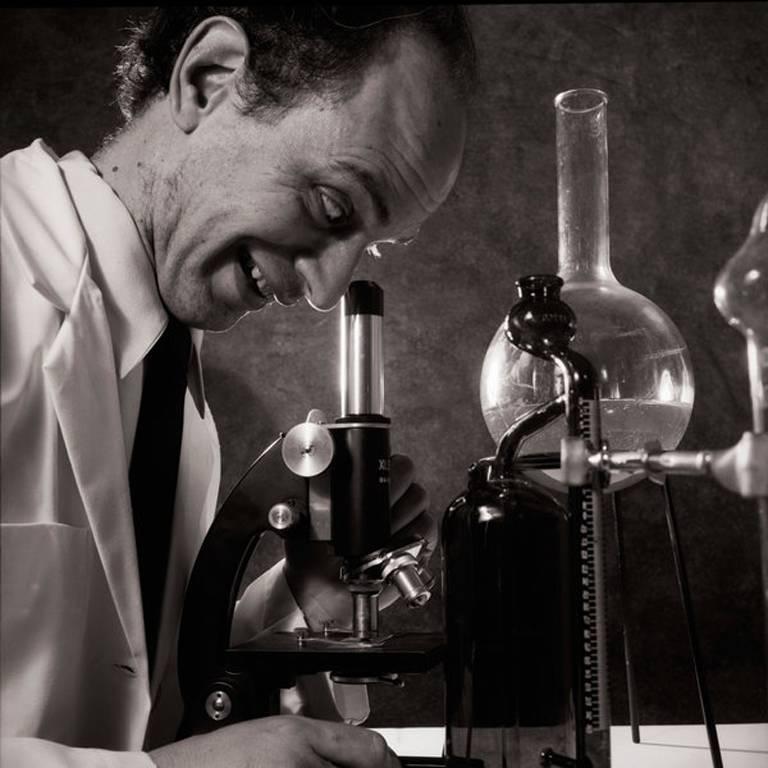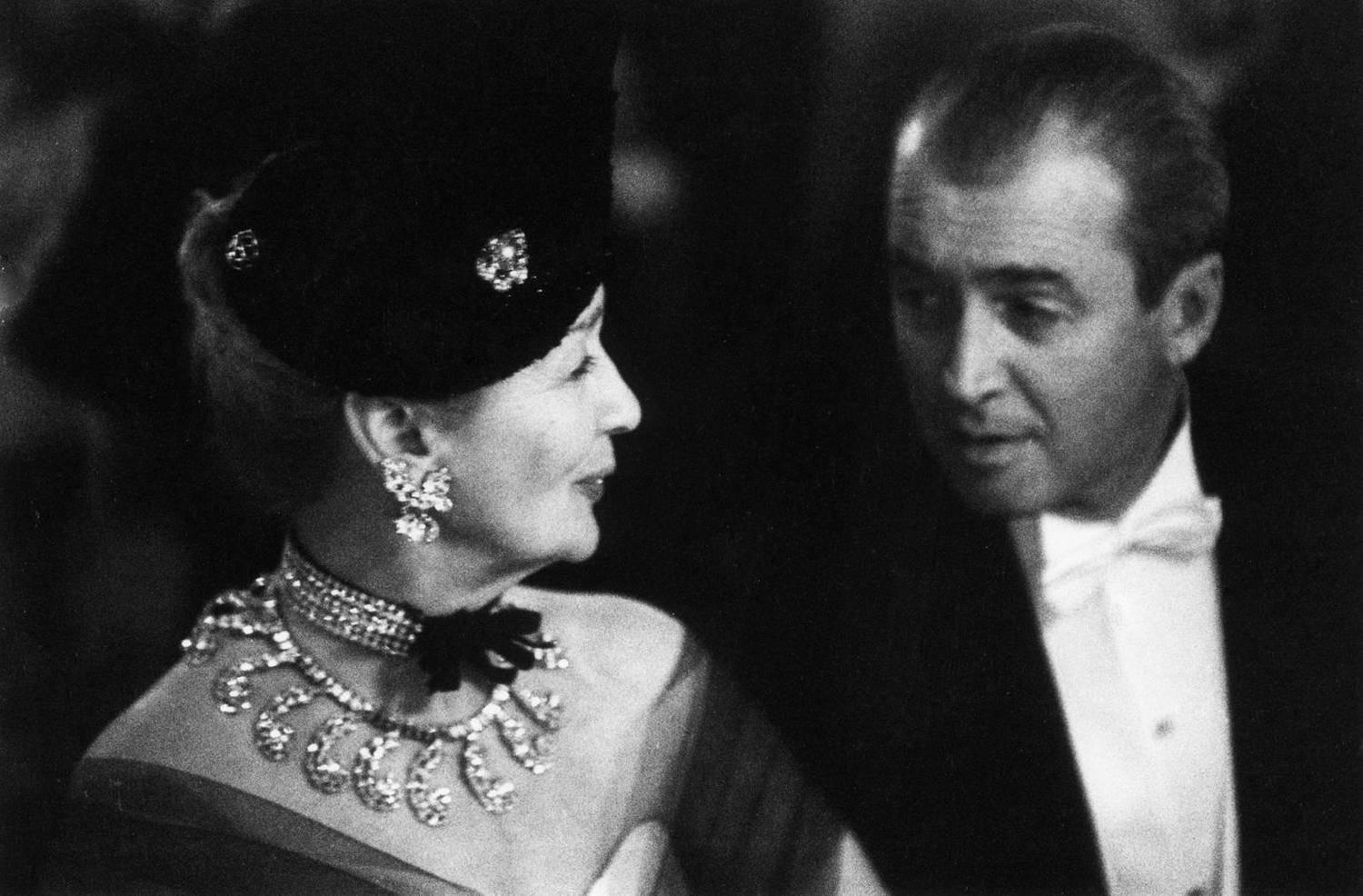Items Similar to Rare Vintage Silver Gelatin and Polaroid Photograph Prints Ansel Adams Portrait
Want more images or videos?
Request additional images or videos from the seller
1 of 6
Rare Vintage Silver Gelatin and Polaroid Photograph Prints Ansel Adams Portrait
About the Item
Rare Vintage Silver Gelatin and Polaroid Photograph Prints in Polaroid Photo Album.
These measure 10 x 8 4.25 x 3.25. it is a folder titled on it Custom Print by Polaroid the album is also embossed with a Polaroid blindstamp. Most probably by Meroe Morse, she was employed by Polaroid and an artist/photographer. It is likely she took this photo of Adams.
Adams, Ansel (Feb. 20 1902 — Apr. 22, 1984), photographer and environmentalist, was born in San Francisco, California. His life was, in his words, “colored and modulated by the great earth gesture” of the Yosemite Sierra (Adams, Yosemite and the Sierra Nevada, p. xiv). He spent substantial time there every year from 1916 until his death. From his first visit, Adams was transfixed and transformed. He began using the Kodak No. 1 Box Brownie his parents had given him. He hiked, climbed, and explored, gaining self-esteem and self-confidence. In 1919 he joined the Sierra Club and spent the first of four summers in Yosemite Valley, as “keeper” of the club’s LeConte Memorial Lodge.
The Sierra Club was vital to Adams’s early success as a photographer. His first published photographs and writings appeared in the club’s 1922 Bulletin, and he had his first one man exhibition in 1928 at the club’s San Francisco headquarters. By 1934 Adams had been elected to the club’s board of directors and was well established as both the artist of the Sierra Nevada and the defender of Yosemite.
Nineteen twenty seven was the pivotal year of Adams’s life. He made his first fully visualized photograph, Monolith, the Face of Half Dome, and took his first High Trip. More important, he came under the influence of Albert M. Bender, a San Francisco insurance magnate and patron of arts and artists. Literally the day after they met, Bender set in motion the preparation and publication of Adams’ first portfolio, Parmelian Prints of the High Sierras. In addition to spending summers photographing in the Sierra Nevada, Adams made several lengthy trips to the Southwest to work with Mary Austin, grande dame of the western literati. Their magnificent limited edition book, Taos Pueblo, was published in 1930. In the same year Adams met photographer Paul Strand, whose images had a powerful impact on Adams and helped to move him away from the “pictorial” style he had favored in the 1920s. Adams began to pursue “straight photography,” in which the clarity of the lens was emphasized, and the final print gave no appearance of being manipulated in the camera or the darkroom.
In 1927 Adams met photographer Edward Weston. They became increasingly important to each other as friends and colleagues. The renowned Group f/64, founded in 1932, coalesced around the recognized greatness of Weston and the dynamic energy of Adams. Although loosely organized and relatively short-lived, Group f/64 brought the new West Coast vision of straight photography to national attention and influence. San Francisco’s DeYoung Museum promptly gave f/64 an exhibition and, in that same year, gave Adams his first one-man museum show.
Although profoundly a man of the West, Adams spent a considerable amount of time in New York during the 1930s and 1940s, and the Alfred Stieglitz circle played a vital role in his artistic life. In 1933 the Delphic Gallery gave Adams his first New York show. His first series of technical articles was published in Camera Craft in 1934, and his first widely distributed book, Making a Photograph, appeared in 1935. Most important, in 1936 Stieglitz gave Adams a one-man show at An American Place.
Clients ran the gamut, including the Yosemite concessionaire, the National Park Service, Kodak, Zeiss, IBM, ATT, a small women’s college, a dried fruit company, and Life, Fortune, and Arizona Highways magazines — in short, everything from portraits to catalogues to Coloramas.
Adams’s technical mastery was the stuff of legend. More than any creative photographer, before or since, he reveled in the theory and practice of the medium. Weston and Strand frequently consulted him for technical advice. He served as principal photographic consultant to Polaroid and Hasselblad and, informally, to many other photographic concerns.
Adams described himself as a photographer — lecturer — writer. It would perhaps be more accurate to say that he was simply — indeed, compulsively — a communicator.
Adams was an unremitting activist for the cause of wilderness and the environment. His images became the symbols, the veritable icons, of wild America. When people thought about the national parks of the Sierra Club or nature of the environment itself, the often envisioned them in terms of an Ansel Adams photograph. His black-and-white images were not “realistic” documents of nature. Instead, they sought an intensification and purification of the psychological experience of natural beauty. He created a sense of the sublime magnificence of nature that infused the viewer with the emotional equivalent of wilderness, often more powerful than the actual thing.
For Adams, the environmental issues of particular importance were Yosemite National Park, the national park system, and above all, the preservation of wilderness.
Though wilderness and the environment were his grand passions, photography was his calling, his metier, his raison d’etre. Adams never made a creative photograph specifically for environmental purposes. Adams was often criticized for failing to include humans or evidence of “humanity” in his landscape photographs. The great French photographer Henri Cartier-Bresson made the well-known comment that “the world is falling to pieces and all Adams and Weston photograph is rocks and trees” There is a vast amount of true and truly protected wilderness in America, much of it saved because of the efforts of Adams and his colleagues.
Seen in a more traditional art history context, Adams was the last and defining figure in the romantic tradition of nineteenth-century American landscape painting and photography. Adams always claimed he was not “influenced,” but, consciously or unconsciously, he was firmly in the tradition of Thomas Cole, Frederic Church, Albert Bierstadt, Carlton Watkins, and Eadweard Muybridge. And he was the direct philosophical heir of the American Transcendentalists Ralph Waldo Emerson, Henry David Thoreau, and John Muir.
- Dimensions:Height: 10 in (25.4 cm)Width: 8 in (20.32 cm)
- Medium:
- Movement & Style:
- Circle Of:Ansel Adams (1902-1984, American)
- Period:
- Condition:The smaller polaroid has some wear to the image from the printing process. minor wear to album. minor wear to album.
- Gallery Location:Surfside, FL
- Reference Number:1stDibs: LU38212475492
About the Seller
4.9
Platinum Seller
These expertly vetted sellers are 1stDibs' most experienced sellers and are rated highest by our customers.
Established in 1995
1stDibs seller since 2014
1,547 sales on 1stDibs
Typical response time: 1 hour
- ShippingRetrieving quote...Ships From: Surfside, FL
- Return PolicyA return for this item may be initiated within 3 days of delivery.
More From This SellerView All
- Vintage Silver Gelatin Photograph Lawrence Lipton Photo Beatnik Beat WriterBy Fred McDarrahLocated in Surfside, FLLawrence Lipton May 17 1965 photographer Fred McDarrah Over a 50-year span, McDarrah documented the rise of the Beat Generation, the city’s postmod...Category
1960s American Modern Black and White Photography
MaterialsSilver Gelatin
- Vintage Silver Gelatin Magnum Press Photo Eve Arnold Marilyn Monroe PhotographBy Eve ArnoldLocated in Surfside, FLMarilyn Monroe Vintage press photo. Photographer Eve Arnold for Magnum Photos. 1962 printed later. (I believe in the early 80's) Eve Arnold, OBE, Hon. ...Category
1960s American Modern Black and White Photography
MaterialsSilver Gelatin
- Vintage Silver Gelatin Photograph Tibor de Nagy Portrait Photo NYC GalleryBy Fred McDarrahLocated in Surfside, FLTibor De Nagy - October 11 1960 Photographer is Fred McDarrah Over a 50-year span, McDarrah documented the rise of the Beat Generation, the city’s postmodern art movement, its off-off-Broadway actors, troubadours, politicians, agitators and social protests. Fred captured Jack Kerouac frolicking with women at a New Year’s bash in 1958, Andy Warhol adjusting a movie-camera lens in his silver-covered factory, and Bob Dylan offering a salute of recognition outside Sheridan Square near the Voice’s old office. Not just a social chronicler, McDarrah was a great photo-journalist. For years, McDarrah was the Voice's only photographer and, for decades, he ran the Voice’s photo department, where he helped train dozens of young photographers, including James Hamilton, Sylvia Plachy, Robin Holland and Marc Asnin. His mailbox was simply marked "McPhoto." An exhibit of McDarrah’s photos of artists presented by the Steven Kasher Gallery in Chelsea was hailed by The New York Times as “a visual encyclopedia of the era’s cultural scene.” artists in their studios, (Alice Neel, Philip Guston, Stuart Davis, Robert Smithson, Jasper Johns, Franz Kline), actors (Dustin Hoffman, Robert De Niro on the set of “Taxi Driver”), musicians (Janis Joplin, Alice Cooper, Bob Dylan) and documentary images of early happenings and performances (Yayoi Kusama, Charlotte Moorman, Al Hansen, Jim Dine, Nam June Paik). The many images of Andy Warhol include the well-known one with his Brillo boxes at the Stable Gallery in 1964. Woody Allen, Diane Arbus, W. H. Auden, Francis Bacon, Joan Baez, Louise Bourgeois, David Bowie, Jimmy Breslin, William Burroughs, John Cage, Leo Castelli, Christo, Leonard Cohen, Merce Cunningham, William de Kooning, Jim Dine, Mark di Suvero, Marcel Duchamp, Bob Dylan, Federico Fellini, Allen Ginsberg, Robert Indiana, Mick Jagger, Jasper Johns, Kusama, John Lennon, Sol Lewitt, Roy Lichtenstein, Nam June Paik, Elvis Presley, Claes Oldenburg, Yoko Ono, Robert Rauschenberg, Lou Reed, James Rosenquist, Mark Rothko, Ed Ruscha, Robert Smithson, Susan Sontag, Andy Warhol, and others. McDarrah’s prints have been collected in depth by the J. Paul Getty Museum and the National Portrait Gallery, Washington. His work is in numerous public and private collections. Tibor de Nagy founded an eponymous Gallery involved in the discovery of many of the Second Generation Abstract Expressionist Movement artists and also representational artists of the era including Nell Blaine, Grace Hartigan, Alfred Leslie, Helen Frankenthaler, Jane Freilicher, Paul Georges, Red Grooms, Ian Hornak, Kenneth Noland, Fairfield Porter and Larry Rivers and established emerging artists including Carl Andre, Helen Frankenthaler, Jane Wilson...Category
1960s American Modern Black and White Photography
MaterialsSilver Gelatin
- Vintage Silver Gelatin Print Photograph Gary Cooper, His Last Photo, SignedLocated in Surfside, FLThis is a vintage black and white photograph (shot in 1961 and printed in 1975) of famed actor Gary Cooper by internationally renowned PhotographerSherman Weisburd. This Vintage photograph was developed from the original negative and is the last portrait photo taken before his death. This photo was selected as a possible cover for Good Housekeeping Magazine. It is hand signed in marker, lower right by Sherman Weisburd. Sherman Weisburd, known for his album cover photos of the 1960s and '70s and advertising work of the early '70s. Photographer for Playboy Magazine, TV Guide (Sonny & Cher), and Viva Magazine. Grammy nominated for his photo of Charles Aznavour, He shot Arlo Guthrie for the cover of Alice's Restaurant, Betty Ford for Ingenue magazine, Marilyn Monroe for Modern Screen magazine. He also shot Ashford & Simpson and was a cinematographer for Universal and Paramount pictures. Gary Cooper was an Oscar winning American actor. A major movie star from the end of the silent film era through to the end of the golden age of Classical Hollywood. Throughout his career, he sustained a screen persona that represented the ideal American hero. In the early 1930s, he expanded his heroic image to include more cautious characters in adventure films and dramas such as A Farewell to Arms (1932) and The Lives of a Bengal Lancer (1935). During the height of his career, Cooper portrayed a new type of hero—a champion of the common man—in films such as Mr. Deeds Goes to Town (1936), Meet John Doe (1941), Sergeant York (1941), The Pride of the Yankees (1942), and For Whom the Bell Tolls (1943). In the postwar years, he portrayed more mature characters at odds with the world in films such as The Fountainhead (1949) and High Noon (1952). In his final films, Cooper played non-violent characters searching for redemption in films such as Friendly Persuasion (1956) and Man of the West (1958). Cooper had a series of romantic relationships with leading actresses, beginning in 1927 with Clara Bow, who advanced his career by helping him get one of his first leading roles in Children of Divorce In 1929, while filming The Wolf Song, Cooper began an intense affair with Lupe Vélez...Category
1960s American Modern Portrait Photography
MaterialsSilver Gelatin
- Vintage Silver Gelatin Photograph Print, Girls on a Beach Photo, Two Man ShowLocated in Surfside, FLRichard Lebowitz, b. 1937, American, (RISD Faculty 1964-1995, Photography; Professor Emeritus) Tom Young, b. 1951, American, (RISD MFA 1977, Photography) TIT...Category
1980s American Modern Black and White Photography
MaterialsPhotographic Paper, Silver Gelatin
- Silver Gelatin Photograph Hand Signed Photo Pablo Picasso w Baby Lucien ClergueBy Lucien ClergueLocated in Surfside, FLLucien Clergue (FRENCH, 1934 - 2014) Gelatin silver photographic print depicting Pablo Picasso holding a baby. Picasso et sa filleule Olivia (Picasso et bébé) Mougins, 1967 Hand signed by the artist with hand written description. Titled and dated lower left. Mounted in a silver painted wooden frame with mat behind acrylic screen. Paper measures approx. 11 3/4" height x 9" width to sight. Framed measures approx. 17 1/4" height x 14 3/4" width. Lucien Clergue (French: 1934 – 2014) was a French photographer. He was Chairman of the Academy of Fine Arts, Paris for 2013. Lucien Clergue was born in Arles, France. At the age of 7 he began learning to play the violin, and after several years of study his teacher admitted that he had nothing more to teach him. Clergue was from a family of shopkeepers and could not afford to pursue further studies in a college or university school of music, such as a conservatory. In 1949, he learned the basics of photography. Four years later, at a corrida in Arles, he showed his photographs to Spanish painter Pablo Picasso who, though subdued, asked to see more of his work. Within a year and a half, young Clergue worked on his photography with the goal of sending more images to Picasso. During this period, he worked on a series of photographs of travelling entertainers, acrobats and harlequins, the Saltimbanques. He also worked on a series whose subject was carrion. On 4 November 1955 Lucien Clergue visited Picasso in Cannes, France. Their friendship lasted nearly 30 years until Picasso's death. Clergue's autobiographical book, Picasso My Friend, looks back on important moments of their relationship. In 1968, and with his friend Michel Tournier, Clergue founded the Rencontres d’Arles photography festival which is held annually in July in Arles. He exhibited his work at the festival during the years 1971–1973, 1975, 1979, 1982–1986, 1989, 1991, 1993, 1994, 2000, 2003 and 2007. Clergue also illustrated books, among them a book by writer Yves Navarre. Clergue took many photographs of the gypsies of southern France, and was instrumental in propelling the guitarist Manitas de Plata to fame. Clergue is perhaps most remembered and respected for his black-and-white studies of light, shadow, and form, featuring sinuous nude female bodies, zebra stripes of light, dynamic sand dunes, and seascapes extracted from the coast of the Camargue. Clergue's photographs are in the collections of numerous well-known museums and private collectors. His vintage photographs have been exhibited in over 100 solo exhibitions worldwide, with noted exhibitions such as in 1961, at the Museum of Modern Art New York, the last exhibition organized by Edward Steichen with Lucien Clergue, Bill Brandt and Yasuhiro Ishimoto. Museums with large collections of his work include The Fogg Museum at Harvard University and the Museum of Fine Arts, Boston. His work, Fontaines du Grand Palais (Fountains of the Grand Palais), is in Museo cantonale d'arte [de] of Lugano. His vintage photographs of Jean Cocteau are on permanent display at the Jean Cocteau Museum in Menton, France. In the U.S., an exhibition of the Cocteau photographs was premiered at Westwood Gallery, New York City. In 2007, the city of Arles honored Lucien Clergue and dedicated a retrospective collection of 360 of his photographs dating from 1953 to 2007. He also received the 2007 Lucie Award. He was named Knight of the Légion d'honneur in 2003 and elected member of the Academy of Fine Arts of the Institute of France on 31 May 2006, at the same time as a new section dedicated to photography was created. Clergue was the first photographer to enter the Academy to a position devoted specifically to photography. He was Chairman of the Academy of Fine Arts for 2013. Lucien Clergue was married to the art curator Yolande Clergue, founder of The Fondation Vincent van Gogh Arles. He was the father of two daughters: Anne Clergue, a curator of contemporary art who has worked at Leo Castelli Gallery, and Olivia Clergue, a handbag fashion designer whose godfather was Pablo Picasso. Pablo Picasso (1881 –1973) was a Spanish painter, sculptor, printmaker, ceramic artist and theatre designer who spent most of his adult life in France. Regarded as one of the most influential artists of the 20th century, he is known for co-founding the Cubist movement, the invention of constructed sculpture, the co-invention of collage, and for the wide variety of styles that he helped develop and explore. Among his most famous works are the proto-Cubist Les Demoiselles d'Avignon (1907), and Guernica (1937), a dramatic portrayal of the bombing of Guernica by German and Italian air forces during the Spanish Civil War. After 1906, the Fauvist work of the slightly older artist Henri Matisse motivated Picasso to explore more radical styles, beginning a fruitful rivalry between the two artists, who subsequently were often paired by critics as the leaders of modern art. In 1897, his realism began to show a Symbolist influence, for example, in a series of landscape...Category
20th Century Modern Black and White Photography
MaterialsSilver Gelatin
You May Also Like
- Friend of the HorseLocated in Detroit, MIFriend of the Horse, Framed, Brown Wood, 2018 Raised in the American West, this region has resonated in mythical proportions within Antonia Stoyanovich...Category
21st Century and Contemporary American Modern Black and White Photography
MaterialsArchival Ink, Photographic Paper
- RowanLocated in Detroit, MIRowan, Archival film photograph with frame, 2018 Raised in the American West, this region has resonated in mythical proportions within Antonia Stoyanovich...Category
21st Century and Contemporary American Modern Portrait Photography
MaterialsArchival Ink, Photographic Paper
- New York City, HarlemBy Harold L. HarveyLocated in Dallas, TXTitled, dated and artist stamp.Category
1930s American Modern Black and White Photography
MaterialsSilver Gelatin
- Steve Mass, the owner of the Mudd ClubBy William CouponLocated in New York, NYSteve Mass, the owner of the Mudd Club Archival pigment print image size: 36 x 36 inches Signed and numbered edition of 15 William Coupon is an...Category
1970s American Modern Black and White Photography
MaterialsArchival Pigment
- Professional Gossip (Slim Aarons Estate Edition)By Slim AaronsLocated in New York, NYAmerican actress and gossip columnist Hedda Hopper (1890 – 1966) chatting with James Stewart (1908 – 1997) during a New Year’s Eve party held at the Romanoff Restaurant in Hollywood,...Category
1950s American Modern Black and White Photography
MaterialsSilver Gelatin
- First Lady To Be, Jacqueline Bouvier (Slim Aarons Estate Edition)By Slim AaronsLocated in New York, NYMichael Canfield and Jacqueline Bouvier (1929 – 1994) at Newport Casino Tennis Week, Newport, Rhode Island, 1955. Estate stamped and hand numbered edition of 150 with certificate of...Category
1950s American Modern Black and White Photography
MaterialsSilver Gelatin





